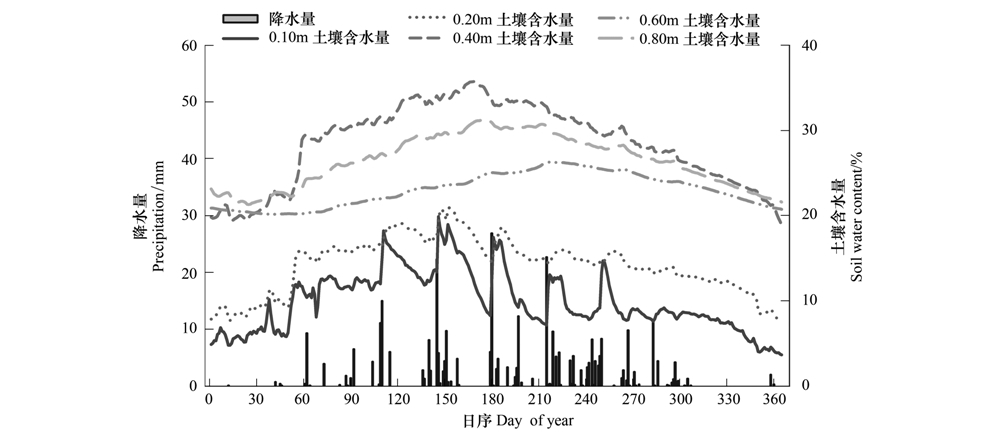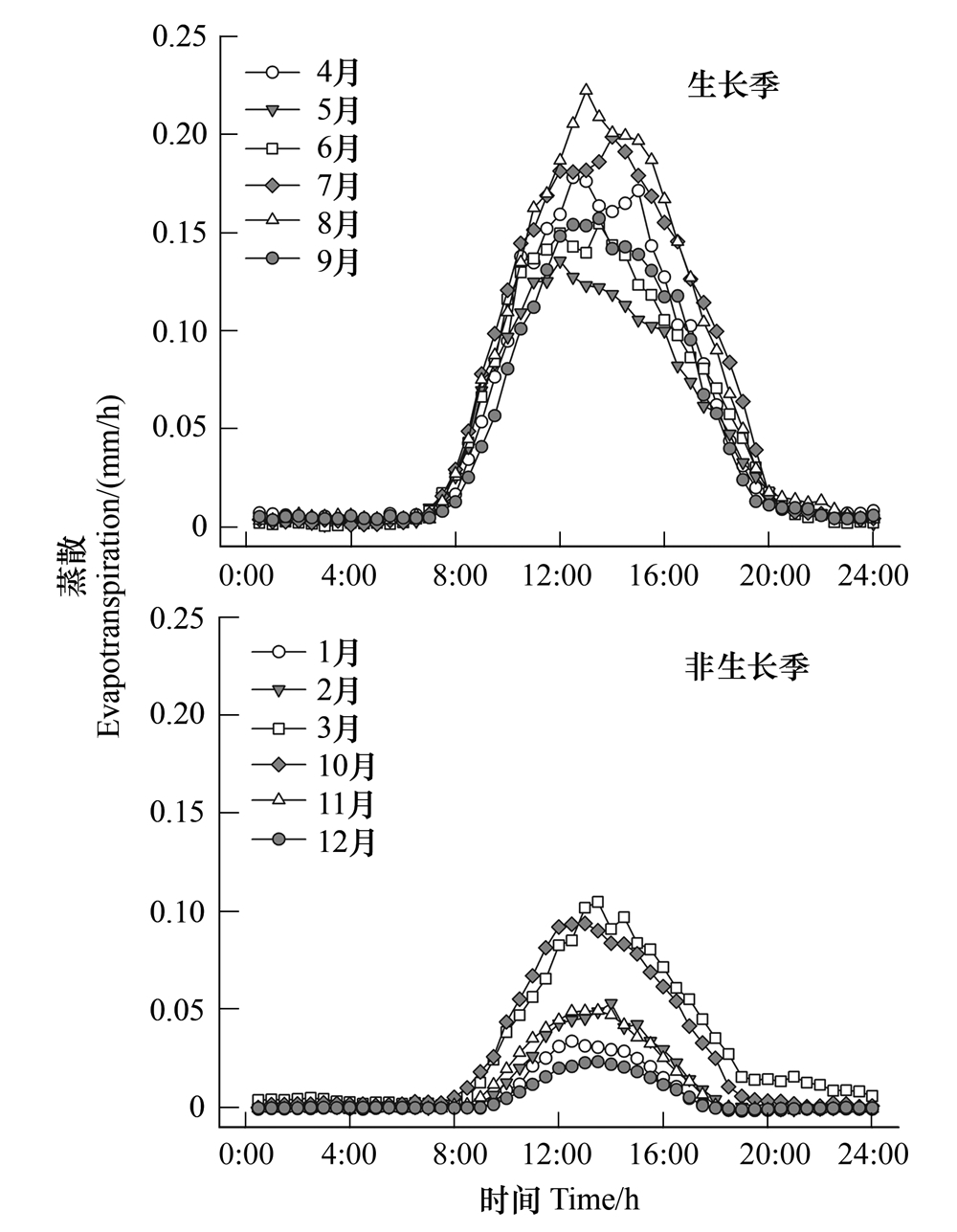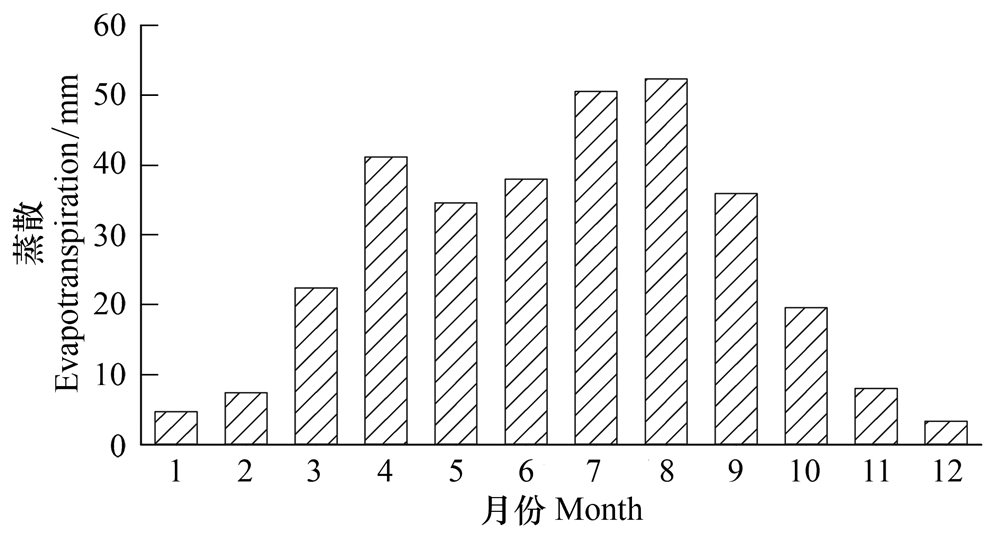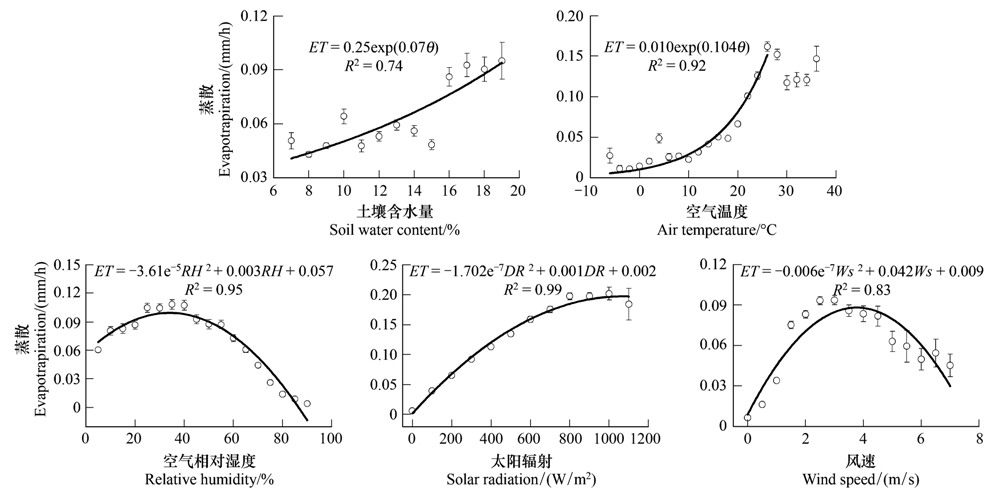文章信息
- 阳伏林, 张强, 王文玉, 张凯, 杨启国, 杨泽粟, 雷俊
- YANG Fulin, ZHANG Qiang, WANG Wenyu, ZHANG Kai, YANG Qiguo, YANG Zesu, LEI Jun
- 黄土高原春小麦农田蒸散及其影响因素
- Evapotranspiration and factors influencing evapotranspiration in the spring wheat farmland of China’s Loess Plateau
- 生态学报, 2014, 34(9): 2323-2328
- Acta Ecologica Sinica, 2014, 34(9): 2323-2328
- http://dx.doi.org/10.5846/stxb201306101609
-
文章历史
- 收稿日期:2013-6-10
- 修订日期:2013-10-10
2. 兰州大学大气科学学院, 兰州 730020;
3. 甘肃省定西市气象局, 定西 743000
2. College of Atmospheric Sciences, Lanzhou University, Lanzhou 730000, China;
3. Meteorological Bureau of Dingxi, Dingxi 743000, China
水分短缺是半干旱区农作物生长常见的限制因子,成为制约地区农业可持续发展的重要因素[1]。半干旱区农田干湿状况与降水、蒸散等生态系统水循环过程密切相关[2]。蒸散是土壤-植物-大气系统中水分传输和转化的主要途径,是农田生态系统水循环的重要环节[3],农业用水中绝大部分(甚至99%)通过蒸散过程返还到大气[4]。黄土高原是我国北方典型旱地农业分布区;大部分地区年降水量较少,雨量变率较大。黄土高原半干旱雨养农业区对降水量变化依赖性极强,是生态和农业脆弱地区[5]。有研究表明,黄土高原地区是响应气候变化的敏感区域,气候变暖将通过加快蒸散过程进而加剧黄土高原地区土壤干旱化程度[6]。掌握黄土高原地区农田蒸散变化特征及其影响因素,对于合理利用有限水资源,以及科学应对气候变化具有重要意义。
有研究表明,黄土高原近40年来蒸散整体呈上升趋势,湿度和温度是蒸散最重要的影响因子[7, 8]。然而,这些研究成果主要基于蒸发皿资料或者由台站气象数据估计参考蒸散资料[9],并非生态系统的实际蒸散,不能较好地反映黄土高原地区水分耗散的真实情况。近年来,涡度相关技术以其测量精度较高、理论假设条件较少,被认为是目前测定生态系统实际蒸散量最为有效的方法之一。本研究基于2010年黄土高原半干旱区野外生态系统观测站的涡度相关系统和气象梯度观测系统资料,分析了农田生态系统蒸散变化特征及其环境主导因子。
1 研究地点与方法 1.1 研究区自然概况研究地点(35°33′N,104°35′E,海拔1896.7 m)位于黄土高原地区甘肃省定西市境内的中国气象局兰州干旱气象研究所干旱气象与生态环境试验基地。该地区属于温带大陆性半干旱气候,年均气温7.1 ℃,年均降水量382.3 mm(来源于1979—2008年定西市气象站数据),其中87%集中于5—10月。研究区域下垫面平坦均匀;地带性土壤为黄土状亚粘土;主要农作物为春小麦。本研究将4—9月份分为生长季,其他6个月份为非生长季。2010年定西市气象站年降水量为399.5 mm,距平差异低于5%。本研究选取2010年观测资料来分析该地区平均降水条件下春小麦农田蒸散特征及其与环境因子的关系。
1.2 研究内容与方法试验基地配备有涡动相关观测系统和气象梯度观测系统进行长期野外观测。涡度相关系统主要用于测定地表与大气间潜热通量(LE)交换,观测高度2.5 m。系统主要由三维超声风速仪(CSAT-3,Campbell Scientific,USA)和CO2/H2O快速响应红外分析仪(Li7500,LI-COR,USA)组成,仪器采样频率10 Hz,实时观测数据记录于数据采集器(CR5000,Campbell Scientific,USA)。为了研究方便,LE数据均处理成半小时平均值。LE正值表示能量从地表向大气中传输,负值则相反。在LE计算之前,将原始观测数据进行二次坐标旋转、Webb-Pearman-Leuning(WPL)校正[10]以及异常值剔除[11]等必要处理。同时,采用Falge等[12]提出的方法对由降水、断电等造成的缺失数据进行插补[13]。蒸散(ET,mm)与潜热通量(LE,MJ/m2)换算关系为 LE=λET ,其中蒸发潜热λ为2.45 MJ/kg。
气象梯度观测系统由1个自动雨量计(52203,RM Young,USA,高度1.5 m)、1个空气温湿度传感器(HMP45C,Vaisala,Finland,观测高度1.5 m)、1个太阳短波辐射传感器(PIR,Eppley,USA,高度1.5 m)、1个净辐射传感器(CN-40,EKO,Japan,高度1.5 m)、1个风速风向传感器(5103V,RM Young,USA,高度2.0 m)等组成,观测量分别为降雨量(P)、空气温度(T)、空气相对湿度(RH)、太阳辐射(DR)、净辐射(Rn)、风速(Ws)和风向(Wd)等。利用水分时域反射仪(CS616,Campbell Scientific,USA)测定地下0.10,0.20,0.40,0.06,0.80 m土壤含水量(θ)。数据采样频率均为0.1 Hz,存储于数据采集器(CR1000,Campbell Scientific,USA)。
2 结果与讨论 2.1 黄土高原春小麦农田降水量与土壤含水量的季节动态农田生态系统蒸散与降水、土壤水分状况密切相关。2010年黄土高原半干旱区农田生态系统全年降水量为332.3 mm。降水主要集中在生长季(285.9 mm),占全年降水量86%,其中5月和8月降水量较大,均超过60 mm。降水过程显著地影响0.10 m和0.20 m土壤含水量,其中0.10 m土壤含水量对降水过程响应极为敏感,随降水事件发生而波动;而0.20 m土壤含水量响应相对滞后。0.10 m土壤含水量生长季期间波动较大;在7.2%—19.9%之间变化,平均值为12.0%。降水过程对0.40、0.60和0.80 m土壤含水量影响较少,这3层土壤含水量季节变化相对较少。从图 1可以看出,生长季内土壤含水量0.40 m层明显大于其他各层,而0.10 m层最低。

|
| 图 1 降水量与不同深度土壤含水量的季节动态 Fig. 1 Seasonal variations of precipitation and soil water content under different soil depth |
将每日相同时刻半小时尺度蒸散值按月份进行平均,分析生态系统蒸散的月均日动态。黄土高原半干旱区农田生态系统生长季蒸散的日变化表现为早晚低、中午高的“单峰型”曲线特征(图 2)。夜间蒸散较低,接近于0,整体变化平稳;日间蒸散变化明显,8:00左右,蒸散速率迅速增大,在正午前后(12:00—14:00间)达到最大值。随后蒸散速率下降,直至20:00左右,蒸散速率下降至0附近。各月蒸散日峰值高度存在明显差异。最大日峰值出现在8月,最低日峰值出现在5月。4—9月各月ET峰值分别为0.18,0.14,0.15,0.20,0.22,0.16 mm/h。非生长季各月蒸散也呈现出与生长季类似的“单峰型”曲线日变化特征,且日变化曲线更为平滑。从图 2可以看出,非生长季各月蒸散日峰值显著低于生长季各月。在非生长季中,3月和10月蒸散日峰值相对较高,分别为0.10和0.09 mm/h,其它4个月蒸散日峰值均低于0.05 mm/h。

|
| 图 2 黄土高原春小麦农田生态系统蒸散日动态 Fig. 2 Diurnal variation of the spring wheat agroecosystem in the Loess Plateau |
黄土高原半干旱区农田生态系统蒸散存在明显季节变化(图 3),与降水季节分布密切相关(图 1)。最大日蒸散率为4.69 mm/d(4月25日);最少日蒸散率为0.02 mm/d(12月23日)。与其他农田生态系统蒸散研究结果相比,本研究中最大日蒸散率值与王欣[14]关于黄土高原冬小麦日蒸散率值(4.60 mm/d)接近,然而明显低于Burba[15]对小麦生态系统7.0 mm/d的报道,这可能与本研究区干旱少雨的气候条件有关。整个生长季平均日蒸散率为(1.38±0.75) mm/d(平均值±标准差),明显低于黄土高原关于冬小麦(1.84 mm/d)和玉米(1.62 mm/d)的短期平均日蒸散率结果[14]。将每日蒸散值按月份进行累加,分析生态系统蒸散月累加值的季节动态。从月蒸散值来看,由于7、8月份降水较多(图 1),蒸散量相对较高;1、2月份降水少,气温低,蒸散量相对较低。非生长季蒸散量显著低于生长季;二者之比为0.26。全年累积蒸散量为318.0 mm,其中生长季蒸散量为252.4 mm,占全年蒸散量79.4%。2010年的年蒸散量略低于年降水量(332.3 mm);全年蒸散量与降水量的比值为95.7%。

|
| 图 3 黄土高原春小麦农田生态系统蒸散季节动态 Fig. 3 Seasonal variations of the spring wheat agroecosystem in the Loess Plateau to environmental factors |
环境因子显著地影响了黄土高原农田生态系统蒸散变化。从图 4可以看出,黄土高原农田蒸散随土壤含水量增大呈指数增长趋势。当温度低于26 ℃,农田蒸散随温度增大呈指数增长趋势;当温度高于26 ℃,随空气温度增大呈降低趋势。农田蒸散随空气相对湿度、太阳辐射、风速增大呈先增大后降低的二次曲线变化趋势。当空气相对湿度大于40%、或太阳辐射大于1000 W/m2,或风速大于3 m/s情况下,蒸散随之降低。
黄土高原春小麦农田生态系统蒸散与环境因子的相关分析结果表明,在生长季,蒸散与净辐射、土壤含水量显著相关,与空气温度、空气相对湿度、饱和水汽压差相关性不明显;在非生长季,蒸散与净辐射、空气温度、土壤含水量显著相关、饱和水汽压差均显著相关,与空气相对湿度相关性不明显(表 1)。在生长季和非生长季净辐射与蒸散相关性最好,说明净辐射是黄土高原农田生态系统蒸散最主要的环境驱动因子。水分蒸发需要能量,蒸散变化依赖于有效能量的多少,因此蒸散和净辐射之间存在显著正相关关系(表 1)。另一个重要环境因子是土壤含水量,黄土高原农田蒸散与之相关性仅次于净辐射。由于大部分蒸散来自于土壤蒸发,因此土壤水分对蒸散影响显著[16]。在干旱半干旱区陆地生态系统,许多研究表明土壤含水量是调节蒸散的重要环境因子[15, 17]。苗海霞[18]认为在土壤水分充足条件下,净辐射是蒸散的主要控制因子;而当土壤水分缺乏时,土壤湿度条件对蒸散影响显著[19]。

|
| 图 4 黄土高原春小麦农田生态系统生长季蒸散对环境因子的响应 Fig. 4 Response of the spring wheat agroecosystem in the Loess Plateau to environmental factors in the growing season |
|
环境因子
Environmental factors | 相关系数
(生长季) Correlation coefficient (growing season) | 相关系数
(非生长季) Correlation coefficient (non-growing season) |
| **P<0.01 | ||
| 净辐射 Net radiation | 0.540* * | 0.716* * |
| 空气温度 Air temperature | 0.153 | 0.589* * |
|
土壤含水量
Soil water content | 0.296* * | 0.596* * |
|
空气相对湿度
Air relative temperature | 0.161 | 0.138 |
|
饱和水汽压差
Vapor pressure deficit | 0.084 | 0.436* * |
蒸散作为重要的生态系统过程受多种环境因子和生物因子共同作用影响,除太阳辐射、土壤含水量、空气相对湿度、气温等非生物环境因子[20],还包括叶面积指数[13]、气孔导度[19]等生物因子[21, 22]。黄土高原农田生态蒸散变化特征是各种环境因子相互作用的结果。当空气温度在一定的范围内,随着温度升高,水分子获得的能量增大,运动加快[23],分子间间隔增大,水易于由液态变成气态;同时,空气温度升高通常伴随饱和水汽差增大[24],进而导致蒸散增加。然而,当温度升高到一定程度以后,由于黄土高于地区土壤干旱缺水,即使温度再升高,有限的土壤水分已不能完全满足蒸散需要,蒸散停止升高趋势(图 4)。蒸散对太阳辐射的响应也存在类似情况(图 4)。风速则通过改变空气动力学阻力来影响蒸散过程[24]。然而,当风速大于一定值,在黄土高原地区通常伴随着空气温度下降,从而蒸散减少(图 4)。空气中水汽在一定范围内是有利于蒸散过程的发生。然当空气相对湿度持续增加,蒸发表面与其临近空气的水汽压差将降低,导致蒸散过程的驱动力下降[25],蒸散呈降低趋势。由于本研究缺少叶面积指数等生物因子观测资料,不能很好地探讨生物因子对蒸散的影响,这是本研究的不足。
3 结论(1)黄土高原半干旱区农田生态系统蒸散呈早晚低、中午高的“单峰型”日变化特征,最大日峰值出现在8月。农田蒸散且具有明显季节动态,与降水季节分布密切相关。
(2)全年(2010年)蒸散量略低于年降水量;蒸散量与降水量的比值为95.7%。
(3)黄土高原农田生态系统蒸散随土壤含水量和空气温度(低于26 ℃)增大呈指数增长趋势;随空气相对湿度、太阳辐射、风速增大呈先增大后降低的二次曲线变化趋势。
(4)净辐射是黄土高原半干旱区农田生态系统蒸散主要环境控制因子,土壤含水量次之。
| [1] | Li F M, Zhao S L, Duan X S, Gao S M, Feng B. Preliminary study on limited irrigation for spring wheat field in semi-arid region of loess plateau. Chinese Journal of Applied Ecology, 1995, 6(3): 259-264. |
| [2] | Liu S, Li S G, Yu G R, Asanuma J, Sugita M, Zhang L M, Hu Z M, Wei Y F. Seasonal and interannual variations in water vapor exchange and surface water balance over a grazed steppe in central Mongolia. Agricultural Water Management, 2010, 97(6): 857-864. |
| [3] | Xie X Q. Connotation and some advances of the research on the water movement and its regional change regular in agro-ecosystem of north China. Advance in Earth Science, 2003, 18(3): 440-446. |
| [4] | Rana G, Katerji N. Measurement and estimation of actual evapotranspiration in the field under Mediterranean climate: a review. European Journal of Agronomy, 2000, 13(2/3): 125-153. |
| [5] | Zhang Q, Wang S. On land surface processes and its experimental study in Chinese Loess Plateau. Advances in Earth Science, 2008, 23(2): 167-173. |
| [6] | Xin Z B, Xu J X, Zheng W. Spatiotemporal variations of vegetation cover on the Chinese Loess Plateau (1981-2006): Impacts of climate changes and human activities. Science in China (Series D), 2008, 51(1): 67-78. |
| [7] | Li Z. Spatiotemporal variations in the reference crop evapotranspiration on the Loess Plateau during 1961-2009. Acta Ecologica Sinica, 2012, 32(12): 4139-4145. |
| [8] | Qiu X F, Liu C M, Zen Y. Changes of pan evaporation in the recent 40 years over the Yellow River Basin. Journal of Natural Resources, 2003, 18(4): 437-442. |
| [9] | Fan J, Shao M A, Wang Q J. Comparison of many equations for calculating reference evapotranspiration in the Loess Plateau of China. Transactions of the Chinese Society of Agricultural Engineering, 2008, 24(3): 98-102. |
| [10] | Webb E K, Pearman G I, Leuning R. Correction of flux measurements for density effects due to heat and water vapour transfer. Quarterly Journal of the Royal Meteorological Society, 1980, 106(447): 85-100. |
| [11] | Papale D, Reichstein M, Aubinet M, Canfora E, Bernhofer C, Kutsch W, Longdoz B, Rambal S, Valentini R, Vesala T, Yakir D. Towards a standardized processing of Net Ecosystem Exchange measured with eddy covariance technique: algorithms and uncertainty estimation. Biogeosciences, 2006, 3(4): 571-583. |
| [12] | Falge E, Baldocchi D, Olson R, Anthoni P, Aubinet M, Bernhofer C, Burba G, Ceulemans R, Clement R, Dolman H, Granier A, Gross P, Grunwald T, Hollinger D, Jensen N O, Katul G, Keronen P, Kowalski A, Lai C T, Law B E, Meyers T, Moncrieff J, Moors E, Munger J W, Pilegaard K, Rannik U, Rebmann C, Suyker A, Tenhunen J, Tu K, Verma S, Vesala T, Wilson K, Wofsy S. Gap filling strategies for long term energy flux data sets. Agricultural and Forest Meteorology, 2001, 107(1): 71-77. |
| [13] | Yang F L, Zhou G S. Characteristics and driving factors of energy budget over a temperate desert steppe in Inner Mongolia. Acta Ecologica Sinica, 2010, 30(21): 5769-5780. |
| [14] | Wang X, Wen J, Wei Z G, Tian H, Wang L, Li Z C, Shi X K, Zhang T T, Liu R, Zhang J H. Study on water deficit of the topsoil over the Chinese Loess Plateau mesa region. Plateau Meteorology, 2009, 28(3): 530-538. |
| [15] | Burba G G, Verma S B. Seasonal and interannual variability in evapotranspiration of native tallgrass prairie and cultivated wheat ecosystems. Agricultural and Forest Meteorology, 2005, 135(1/4): 190-201. |
| [16] | Jung M, Reichstein M, Ciais P, Seneviratne S I, Sheffield J, Goulden M L, Bonan G, Cescatti A, Chen J Q, De Jeu R, Dolman A J, Eugster W, Gerten D, Gianelle D, Gobron N, Heinke J, Kimball J, Law B E, Montagnani L, Mu Q Z, Mueller B, Oleson K, Papale D, Richardson A D, Roupsard O, Running S, Tomelleri E, Viovy N, Weber U, Williams C, Wood E, Zaehle S, Zhang K. Recent decline in the global land evapotranspiration trend due to limited moisture supply. Nature, 2010, 467(7318): 951-954. |
| [17] | Yang F L, Zhou G S. Characteristics and modeling of evapotranspiration over a temperate desert steppe in Inner Mongolia, China. Journal of Hydrology, 2011, 396(1/2): 139-147. |
| [18] | Miao H X. Effects of Cultivation and Grazing on Evapotranspiration of Steppe Ecosystems in Inner Mongolia, China . Beijing: Institute of Botany, Chinese Academy of Sciences, 2008. |
| [19] | Wever L A, Flanagan L B, Carlson P J. Seasonal and interannual variation in evapotranspiration, energy balance and surface conductance in a northern temperate grassland. Agricultural and Forest Meteorology, 2002, 112(1): 31-49. |
| [20] | Monteith J L, Unsworth M H. Principles of Environmental Physics. 3rd ed. Amsterdam: Academic Press of Elsevier, 2008: 250-257. |
| [21] | Wang K, Dickinson R E. A review of global terrestrial evapotranspiration: Observation, modeling, climatology, and climatic variability. Reviews of Geophysics, 2012, 50(2): RG2005. |
| [22] | Farahani H J, Howell T A, Shuttleworth W J, Bausch W C. Evapotranspiration: progress in measurement and modeling in agriculture. Transactions of the American Society of Agricultural and Biological Engineers, 2007, 50(5): 1627-1638. |
| [23] | Singer K D, Kuzyk M G, Sohn J E. Second-order nonlinear-optical processes in orientationally ordered materials: relationship between molecular and macroscopic properties. Journal of the Optical Society of America B, 1987, 4(6): 968-976. |
| [24] | Allen R G, Pereira L S, Raes D, Smith M. Crop Evapotranspiration: Guidelines for Computing Crop Water Requirements. Rome: FAO, 1998: 21-21. |
| [25] | Chapin I F S, Matson P A, Mooney H A. Principles of Terrestrial Ecosystem Ecology. New York: Springer-Verlag, 2002: 62-62. |
| [1] | 李凤民, 赵松岭, 段舜山, 高世铭, 冯波. 黄土高原半干旱区春小麦农田有限灌溉对策初探. 应用生态学报, 1995, 6(3): 259-264. |
| [3] | 谢贤群. 我国北方地区农业生态系统水分运行及区域分异规律研究的内涵和研究进展. 地球科学进展, 2003, 18(3): 440-446. |
| [5] | 张强, 王胜. 关于黄土高原陆面过程及其观测试验研究. 地球科学进展, 2008, 23(2): 167-173. |
| [7] | 李志. 黄土高原1961—2009年参考作物蒸散量的时空变异. 生态学报, 2012, 32(12): 4139-4145. |
| [8] | 邱新法, 刘昌明, 曾燕. 黄河流域近40年蒸发皿蒸发量的气候变化特征. 自然资源学报, 2003, 18(4): 437-442. |
| [9] | 樊军, 邵明安, 王全九. 黄土区参考作物蒸散量多种计算方法的比较研究. 农业工程学报, 2008, 24(3): 98-102. |
| [13] | 阳伏林, 周广胜. 内蒙古温带荒漠草原能量平衡特征及其驱动因子. 生态学报, 2010, 30(21): 5769-5780. |
| [14] | 王欣, 文军, 韦志刚, 田辉, 王磊, 李振朝, 史小康, 张堂堂, 刘蓉, 张静辉. 中国黄土高原塬区表层土壤水分盈缺状况的研究. 高原气象, 2009, 28(3): 530-538. |
| [18] | 苗海霞. 开垦和放牧对内蒙古半干旱草原蒸发散的影响 [D]. 北京: 中科院植物研究所, 2008. |
 2014, Vol. 34
2014, Vol. 34




